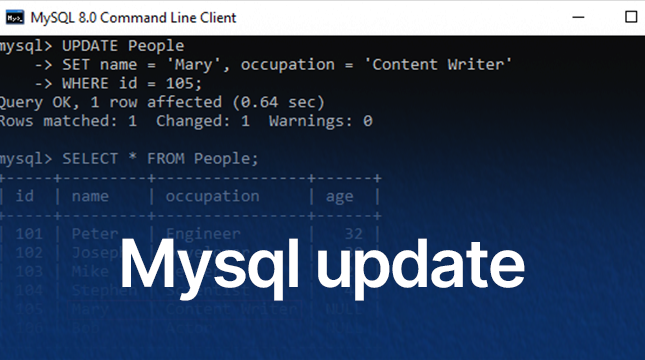This website uses cookies so that we can provide you with the best user experience possible. Cookie information is stored in your browser and performs functions such as recognising you when you return to our website and helping our team to understand which sections of the website you find most interesting and useful.
MySQL UPDATE Statement | Complete Guide

The MySQL UPDATE statement allows you to change existing data in a table. In this guide, we’ll walk through how the UPDATE command works, when to use it, and the best practices to ensure your updates are accurate and safe.
Basic UPDATE Syntax
The fundamental syntax of the MySQL UPDATE statement is:
# Update specific columns in a table based on a condition
UPDATE table_name
SET
column1 = value1,
column2 = value2, ...
WHERE condition;
Components Breakdown
- UPDATE: Keyword that initiates the update operation
- table_name: The table you want to modify
- SET: Specifies which columns to update and their new values
- WHERE: Defines which rows to update (crucial for safety)
| Employee ID | Name | Department | Salary | Status | Years of Service | Performance Rating | Bonus | Last Updated |
|---|---|---|---|---|---|---|---|---|
| 101 | Alice Johnson | Engineering | 60000 | Active | 4 | Intermediate | 4800 | 2025-09-23 10:00:00 |
| 102 | Bob Smith | Sales | 55000 | Active | 6 | Senior | 5500 | 2025-09-23 09:30:00 |
| 103 | Carol Davis | Marketing | 50000 | Inactive | 2 | Junior | 0 | 2025-09-22 15:45:00 |
| 104 | David Lee | Engineering | 62000 | Active | 7 | Senior | 4960 | 2025-09-21 11:20:00 |
| 105 | Eva Brown | Sales | 53000 | Active | 1 | Junior | 0 | 2025-09-20 08:10:00 |
Simple UPDATE Examples
Update Single Column
# Update the salary of a specific employee
UPDATE employees
SET salary = 55000
WHERE employee_id = 101;
Update Multiple Columns
# Update salary, department, and last_updated for a specific employee
UPDATE employees
SET
salary = 60000,
department = 'Engineering',
last_updated = NOW()
WHERE employee_id = 101;
Update Using Expressions
# Increase price by 10% for all electronics products
UPDATE products
SET price = price * 1.10
WHERE category = 'electronics';
UPDATE with WHERE Clause
-- Update specific employee
UPDATE employees
SET status = 'active'
WHERE employee_id = 123;
-- Update multiple employees with condition
UPDATE employees
SET salary = salary * 1.05
WHERE department = 'sales' AND hire_date < '2020-01-01';
-- Update with multiple conditions
UPDATE products
SET discount = 10
WHERE category = 'clothing'
AND price > 50
AND stock_quantity > 0;
UPDATE with Functions and Expressions
String Functions
# Update email and name for customers created after 2024-01-01
UPDATE customers
SET
email = LOWER(email),
name = TRIM(name)
WHERE created_date >= '2024-01-01';
Date Functions
# Schedule delivery 7 days after order date for pending orders
UPDATE orders
SET
delivery_date = DATE_ADD(order_date, INTERVAL 7 DAY),
status = 'scheduled'
WHERE status = 'pending';
Mathematical Operations
# Update price with 15% increase and calculate tax for active products
UPDATE products
SET
price = ROUND(price * 1.15, 2),
tax_amount = price * 0.08
WHERE active = 1;
Conditional UPDATE with CASE
Use CASE statements for complex conditional logic:
# Update product status based on quantity for electronics category
UPDATE products
SET status = CASE
WHEN quantity = 0 THEN 'out_of_stock'
WHEN quantity < 5 THEN 'low_stock'
ELSE 'in_stock'
END
WHERE category = 'electronics';
Multiple CASE Conditions
# Update bonus and performance_rating based on department and years_of_service
UPDATE employees
SET
bonus = CASE
WHEN department = 'sales' THEN salary * 0.10
WHEN department = 'engineering' THEN salary * 0.08
WHEN department = 'marketing' THEN salary * 0.06
ELSE 0
END,
performance_rating = CASE
WHEN years_of_service > 5 THEN 'senior'
WHEN years_of_service > 2 THEN 'intermediate'
ELSE 'junior'
END;
UPDATE with Subqueries
| Order ID | Customer ID | Status | Order Date | Total Amount | Shipped Date | Total Weight |
|---|---|---|---|---|---|---|
| 301 | 501 | Processing | 2025-09-20 09:00 | 350 | – | 12 |
| 302 | 502 | Confirmed | 2025-09-21 14:30 | 1200 | – | 8 |
| 303 | 503 | Shipped | 2025-09-22 11:45 | 450 | 2025-09-23 08:00 | 15 |
| 304 | 501 | Calculating | 2025-09-22 16:10 | 600 | – | 20 |
| 305 | 504 | Completed | 2025-09-19 10:20 | 250 | 2025-09-20 12:00 | 7 |
Using Subqueries in SET Clause
# Update average_rating in products table based on reviews
UPDATE products
SET average_rating = (
SELECT AVG(rating)
FROM reviews
WHERE reviews.product_id = products.product_id
)
WHERE product_id IN (
SELECT DISTINCT product_id FROM reviews
);
Subquery in WHERE Clause
# Update customers to 'vip' if their total orders since 2024-01-01 exceed 5000
UPDATE customers
SET status = 'vip'
WHERE customer_id IN (
SELECT customer_id
FROM orders
WHERE order_date >= '2024-01-01'
GROUP BY customer_id
HAVING SUM(total_amount) > 5000
);
UPDATE with JOINs
Join multiple tables to update based on related data:
Basic JOIN UPDATE
# Apply 15% discount to orders of premium members
UPDATE orders o
JOIN customers c ON o.customer_id = c.customer_id
SET o.discount = 15
WHERE c.membership_type = 'premium';
Multiple Table JOIN
# Update markup_percentage based on category and supplier type
UPDATE products p
JOIN categories cat ON p.category_id = cat.category_id
JOIN suppliers s ON p.supplier_id = s.supplier_id
SET p.markup_percentage = CASE
WHEN cat.category_name = 'luxury' THEN 50
WHEN s.supplier_type = 'direct' THEN 30
ELSE 25
END;
UPDATE with ORDER BY and LIMIT
Control which rows get updated first and limit the number of updates:
-- Update oldest completed orders first
UPDATE orders
SET status = 'archived'
WHERE status = 'completed'
ORDER BY order_date ASC
LIMIT 100;
-- Assign highest priority pending tasks to manager
UPDATE tasks
SET assigned_to = 'manager'
WHERE status = 'pending'
ORDER BY priority DESC, created_date ASC
LIMIT 10;
Multi-table UPDATE
Update multiple tables simultaneously:
# Update total_weight, line_total, and times_ordered for confirmed orders
UPDATE orders o
JOIN order_items oi ON o.order_id = oi.order_id
JOIN products p ON oi.product_id = p.product_id
SET
o.total_weight = o.total_weight + (oi.quantity * p.weight),
oi.line_total = oi.quantity * oi.unit_price,
p.times_ordered = p.times_ordered + oi.quantity
WHERE o.status = 'confirmed';
UPDATE with JSON (MySQL 5.7+)
Updating JSON Values
# Update user theme preference to dark using JSON_SET
UPDATE users
SET preferences = JSON_SET(preferences, '$.theme', 'dark')
WHERE user_id = 123;
JSON Array Operations
# Append 'bestseller' tag to products with top 10 sales_rank
UPDATE products
SET tags = JSON_ARRAY_APPEND(tags, '$', 'bestseller')
WHERE sales_rank <= 10;
Complex JSON Updates
# Update multiple JSON settings for premium users
UPDATE user_profiles
SET settings = JSON_SET(
settings,
'$.notifications.email', true,
'$.privacy.show_profile', false,
'$.last_updated', NOW()
)
WHERE user_type = 'premium';
Safety Practices
Always Use WHERE Clause
-- DANGEROUS: Updates all rows
UPDATE products
SET price = 100;
-- SAFE: Updates only specific rows
UPDATE products
SET price = 100
WHERE category = 'clearance';
Enable Safe Update Mode
# Enable safe updates mode to prevent accidental full-table updates
SET SQL_SAFE_UPDATES = 1;
Use Transactions
# Start a transaction to safely transfer funds between accounts
START TRANSACTION;
UPDATE accounts
SET balance = balance - 100
WHERE account_id = 1;
UPDATE accounts
SET balance = balance + 100
WHERE account_id = 2;
# If everything is correct, save changes
COMMIT;
# If there is an issue, revert changes
ROLLBACK;
Test with SELECT First
-- Test your condition first to avoid accidental updates
SELECT *
FROM employees
WHERE department = 'marketing';
-- Then run the update once confirmed
UPDATE employees
SET salary = salary * 1.05
WHERE department = 'marketing';
Common UPDATE Patterns
Increment/Decrement Values
# Increment the view count of a specific product
UPDATE products
SET view_count = view_count + 1
WHERE product_id = 123;
# Decrement the inventory quantity for a specific product
UPDATE inventory
SET quantity = quantity - 5
WHERE product_id = 456;
Toggle Boolean Values
# Toggle the 'active' status of a specific user
UPDATE users
SET active = NOT active
WHERE user_id = 789;
Update Based on Another Column
# Recalculate total_amount for orders with status 'calculating'
UPDATE orders
SET total_amount = subtotal + tax_amount + shipping_cost
WHERE status = 'calculating';
Batch Status Updates
# Update orders to shipped status for west coast warehouse
UPDATE orders
SET
status = 'shipped',
shipped_date = NOW()
WHERE
status = 'processing'
AND warehouse_location = 'west_coast';
Performance Considerations
Use Indexes on WHERE Conditions
# Ensure indexed columns for faster WHERE lookups
CREATE INDEX idx_orders_status
ON orders(status);
CREATE INDEX idx_products_category
ON products(category);
Batch Large Updates
# Process large updates in batches to avoid locking the table
UPDATE products
SET last_updated = NOW()
WHERE
category = 'books'
AND last_updated IS NULL
LIMIT 1000;
Monitor Performance
# Check the execution plan for an update query
EXPLAIN
UPDATE products
SET price = price * 1.1
WHERE category = 'electronics';
Error Handling
Common Errors and Solutions
Error 1175: Safe Update Mode
# Solution: Temporarily disable safe updates to run a full update
SET SQL_SAFE_UPDATES = 0;
UPDATE table_name
SET column = value;
SET SQL_SAFE_UPDATES = 1;
Error 1062: Duplicate Key
# Handle duplicate key violations by ignoring conflicts
UPDATE IGNORE products
SET sku = CONCAT(sku, '_v2')
WHERE category = 'electronics';
Best Practices Summary
- Always use the WHERE clause unless updating the entire table intentionally
- Test with SELECT before running UPDATE
- Use transactions for critical operations
- Enable safe update mode for protection
- Create backups before major updates
- Index WHERE conditions for performance
- Process large updates in batches
- Use appropriate data types in SET clauses
- Validate results after UPDATE operations
- Document complex UPDATE logic with comments
Also Read:
How to create tables in MySQL?
Joi database full guide
Conclusion
The MySQL UPDATE statement is a powerful tool for data manipulation. By understanding its various forms, from simple single-column updates to complex multi-table operations with JOINs and subqueries, you can efficiently modify your database records while maintaining data integrity and performance.
Remember to always prioritize safety by using WHERE clauses, testing operations, and implementing proper backup strategies. With these fundamentals mastered, you’ll be able to handle any UPDATE scenario confidently and effectively.
FAQs
1. What is the MySQL UPDATE statement?
The UPDATE statement is used to modify existing records in a table. You can update one or multiple columns for specific rows using the WHERE clause.
2. What happens if I omit the WHERE clause?
If you don’t include a WHERE clause, all rows in the table will be updated, which can be dangerous. Always double-check your query before running it.
3. How do I handle errors while updating?
Common errors include:
Error 1175 (Safe Update Mode): Add a WHERE clause or temporarily disable safe updates.
Error 1062 (Duplicate Key): Use UPDATE IGNORE or adjust unique values.
4. Can I update multiple columns at once?
Yes! You can separate column updates with commas. For example:
# Update salary and status for a specific employee
UPDATE employees
SET
salary = 65000,
status = 'active'
WHERE employee_id = 101;

Let's Start Your Project
Get free consultation for your digital product idea to turn it into reality!
Get Started






